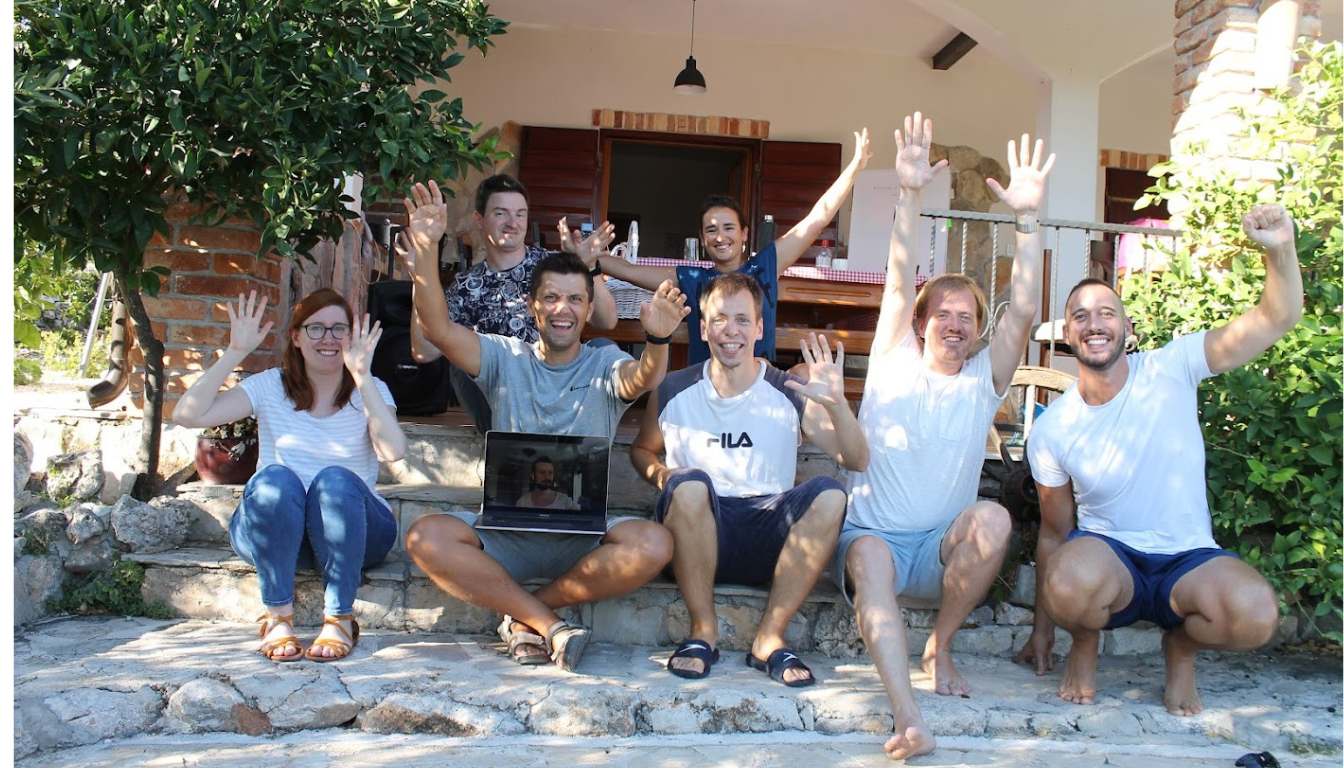How to Increase ROI at Your Team Retreat: A Step-by-Step Guide

6 Ways To Increase ROI At Your Next Team Retreat
Employee engagement, retention, and alignment at remote and hybrid companies is more challenging than ever before.
Layoffs, dwindling VC funding, and the constant demand for increased productivity make the workplace a stressful environment.
In the face of these challenges, it's essential to consider the value of team retreats and how they can boost your team's morale, productivity, and overall success.
Team retreats have evolved to become an indispensable part of maintaining a cohesive and motivated team, especially in remote and hybrid work settings. There are virtual retreat ideas and activities to inspire your team that you can take advantage of.
In this guide, we'll explore the steps to plan a successful team retreat that not only re-energizes your team but also fosters alignment and peak performance.
As the founder/CEO of Offsite, a company that makes team retreat planning more affordable, faster, and stress-free for hundreds of VC-backed startups, Inc 5000s, publicly-traded companies, and others, I'm hoping these pro-tips can convince you that planning team retreats should become a high priority, especially if you manage a remote or hybrid team.
Step 1: Define Clear Objectives for Net Profit

Before diving into the logistics of planning a team retreat, start by defining your objectives. It’s crucial to understand what you aim to achieve through the retreat.
- Are you looking to engage and retain top talent?
- Do you want to incorporate strategic planning sessions or offer personal and professional development opportunities?
- Perhaps it’s a celebration, relaxation, or motivation-focused event.
Ensure that only a select few, such as executives or team leaders, make these high-level decisions. Your objectives will shape the retreat’s timing, location, agenda, and more. ROI calculations can help in evaluating the success of these objectives by integrating various metrics, such as customer acquisition cost and risk-adjusted returns, to provide a nuanced understanding of profitability and investment potential.
Understanding ROI

Return on Investment (ROI) is a crucial financial metric that helps businesses measure the profitability of their investments. By calculating ROI, you can determine how much profit your initial investment has generated. The ROI formula is straightforward: divide the net profit by the initial investment cost. This calculation provides a clear picture of the return on investment (ROI) and helps in making informed decisions.
ROI is versatile and can be applied to various types of investments and industries. Whether you’re evaluating the return on equity, return on ad spend, or return on assets, understanding ROI is essential. It allows businesses to assess their financial health and growth by comparing the net profits against the investment cost. Expressed as a percentage or a ratio, ROI is a key performance metric that guides businesses in evaluating different investments and optimizing their financial strategies.
Step 2: Budget Wisely for Initial Investment
Budgeting is a critical aspect of retreat planning.
You don’t want to be surprised by fees, last-minute additions, travel costs, etc. And so, budgeting at the beginning of your team retreat planning efforts will save some headaches later on.
Some of the top-line items to consider are: the initial cost and maintenance costs when planning the budget for a team retreat. Understanding these costs is crucial for evaluating the return on investment (ROI) and ensuring the profitability of your retreat.
- Airfare
- Hotel room blocks (including room nights, tax, resort fees, and parking)
- Meeting space (including A/V, food and beverage minimums, and tax)
- Meals at your venue, as well as out-on-the-town and consumed during travel
- Uber, Lyft, or shuttle service to and from your venue(s) from the airport
- Uber, Lyft, or shuttle service to and from your venue(s) to team activities
- Any activities you plan for your team
- Keynote speakers and/or outside facilitators
- Photographers and/or videographers
- Swag
One of the most expensive and consequential decisions will be your hotel, as you’ll likely spend most of your budget there between rooms, meals, meeting space, and more. Hotel contracts can get confusing, so at Offsite we’ve put together a guide to understanding terms on a hotel room block contract so you can ensure you’re educated and protected.
You can use Brex or Ramp to issue temporary credit cards with limits to your team so they can book their own airfare and cover incidentals while traveling, and work to negotiate with hotels and meeting space providers in order to save.
In all, you’ll likely spend $1,500 to $2,500 per person, per Offsite (unless you are really looking to ball out for a President’s Club event, executive team retreat, or Board Meeting, where it might get to $3,000+ per person).
Choosing the Right Venue and Activities
Selecting the perfect venue and activities for your team retreat is pivotal to its success. The right venue should be easily accessible, comfortable, and equipped with all necessary amenities to ensure a smooth and enjoyable experience. When choosing a venue, consider factors such as location, capacity, and the specific needs of your team. An ideal venue should accommodate your team comfortably and provide the facilities required for your planned activities.
Equally important are the activities you choose for the retreat. These should be engaging, relevant, and aligned with the retreat’s objectives. Consider incorporating a mix of team building exercises, workshops, and brainstorming sessions that foster collaboration and creativity. Activities should not only be fun but also contribute to the overall goals of the retreat, whether it’s enhancing team cohesion, developing new skills, or strategic planning. By carefully selecting the right venue and activities, you can create a productive and memorable retreat experience.
Step 3: Gather Input Before and After Your Team Retreat

While you don’t want to have “culture committees” of 10+ people chiming in with their ideas, slowing down the decision-making process at every turn, once you decide on high-level objectives for your offsite, you do want to send a pre-offsite feedback form to your team, asking them very specific questions to engage them months before your team retreat takes place.
This is a great opportunity to cover the basics of dietary preferences, any travel sensitivities your team may have, and expectations your team may have for the upcoming offsite.
You can also ask more specific questions about what type of activities your team might want to experience, what their hopes are in terms of career development, what ideas they have that can improve the agenda, and how you (as a manager or team leader) might be able to improve their work lives on a day-to-day basis even before the team retreat takes place. Understanding cash flows can help in evaluating the financial impact of these activities on ROI.
Finally, you might want to poll the team for employee engagement metrics like an employer net promoter score before the offsite and after to see if regularly-occurring team retreats are making a measurable difference in employee engagement, satisfaction, and alignment.
Step 4: Plan Thoughtful Agendas
Every team retreat will have a different agenda, but some of the building blocks are the same for all effective offsites.
For one, you have to factor in enough time for your team to travel in for the team retreat and travel back home.
That means the first day of your retreat should be lighter on programming, and it is recommended you provide your team ample time to recover from potentially stressful travel, acclimate to the new environment, and transition from their daily lives into the new experience of your retreat.
The first night, host a welcome dinner and activity and keep programming light and fun.
For the remainder of your time together, give your attendees a mix of team-building (through fun diversity and inclusion icebreakers, workshops with an outside facilitator, and activities that lead to deep, meaningful connections via unique shared experiences), skill-building (through keynote speakers or presentations from your team to one another to share what each other is working on), strategic planning, and fun.
Don't forget to add lots of “flex time” to your agenda in case you run over, and to give your team time to call home, workout, take a nap, and stay energized through what might be an intense and emotionally draining time for those who aren't used to being around lots of people.
Offsite has a free All Hands meeting agenda you may find interest in...
Leverage Technology and Automation

In today’s fast-paced business environment, leveraging technology and automation is essential for optimizing ROI. Technology can automate repetitive tasks, reduce costs, and improve overall efficiency, leading to better investment returns. For instance, project management tools can streamline processes and enhance productivity, while marketing automation software can manage and optimize marketing campaigns effectively.
Data analytics tools are invaluable for measuring and optimizing ROI, providing insights into how different investments are performing. Additionally, customer service software can enhance the customer experience, leading to increased satisfaction and loyalty. By integrating these technologies into your business operations, you can reduce errors, save time, and ultimately improve your financial performance. Embracing technology and automation is a strategic move that can significantly boost your ROI.
Step 5: Implement an Action Plan For What Happens After Your Team Retreat
After the team retreat, it’s crucial to implement a well-structured action plan to ensure that the goals and objectives set during the retreat are achieved. This plan should outline clear goals, specific tasks, responsibilities, and a timeline for completion. Assigning roles and setting deadlines ensures accountability and keeps the team focused on achieving the desired outcomes.
The action plan should include metrics for measuring success and regular check-ins to monitor progress. This helps in identifying any issues early and making necessary adjustments. By having a detailed action plan, you can ensure that the insights and ideas generated during the retreat are effectively translated into actionable steps, optimizing the ROI from your team retreat.
Optimize Cost Management

Effective cost management is essential for optimizing ROI. By identifying and reducing unnecessary costs, businesses can improve efficiency and maximize their investment returns. Start by analyzing your expenses and identifying areas where costs can be cut without compromising quality. Implementing cost-saving measures, such as negotiating with suppliers and vendors, can also lead to significant savings.
Optimizing resources and improving efficiency are key components of cost management. This can be achieved by streamlining processes and eliminating waste. Additionally, using cost management software can help track expenses and identify opportunities for savings. By focusing on cost management, businesses can reduce their overall expenses, improve their net income, and achieve a higher ROI.
By following these steps and incorporating these strategies, you can ensure that your next team retreat not only boosts morale and productivity but also delivers a significant return on investment.
Step 5: Implement an Action Plan and Calculate ROI For What Happens *After* Your Team Retreat
Hopefully, if you are intentional about how you’d like to use your team’s time at an offsite, you’ll walk away with breakthrough ideas, action items, and notes that you’d like to use post-retreat.
However, many teams forget to implement a system by which great ideas, notes, and conversations become action.
At Offsite, we recommend assigning someone company-wide to be the “scribe” during important sessions, or multiple scribes if there are breakout groups, to ensure notes are recorded during brainstorming and problem-solving exercises.
It is also recommended notes be recorded digitally for easy conversion to your project management system, be it Asana, Notion, or elsewhere.
Further, for action items, you may follow the practice of noting “who” (person on your team) needs to do “what” (action item) by “when” (due date).
The action plan should include metrics for measuring success and regular check-ins to monitor progress. The ROI figure can be used as a key metric for evaluating the success of the retreat.
The ROI from your team retreats truly happens in follow-up, so don’t forget this important step!
Step 6: Leverage Team Retreats for Employer Marketing Campaigns

We recommend hiring a photographer and/or videographer for some or all of your team retreats in order to capture content. You can show the world how awesome your company is by sharing it on your website or social.
Additionally, these offsites should lead to peak experiences for your team. You can ask your employees in the weeks following to leave reviews on GlassDoor or other employment websites. This further helps to increase your ability to hire and retain more great people in the future.
If it’s also apparent you host regular team retreats for your employees, it will be all the more enticing for friends of your team to inquire about job openings at your company, and you’ll be able to find talent with ease.
While employer marketing shouldn’t be the main reason you host an offsite, it is an added ROI that you shouldn’t forget about when planning an effective team retreat. Understanding the annualized ROI of these retreats can help in evaluating their long-term impact on the company.
Team retreats are essential for building strong company cultures, particularly in remote and hybrid environments.
At Offsite, we specialize in helping teams plan memorable in-person experiences that combat isolation and enhance team cohesion.
To discover how we can save you time, money, and reduce the stress of planning retreats, visit www.offsite.com.
FAQs
You may also like
Unique spaces for your next offsite
Find distinctive venues for your upcoming corporate retreat.
Stay Updated with Our Insights
Get exclusive content and valuable updates directly to you.







